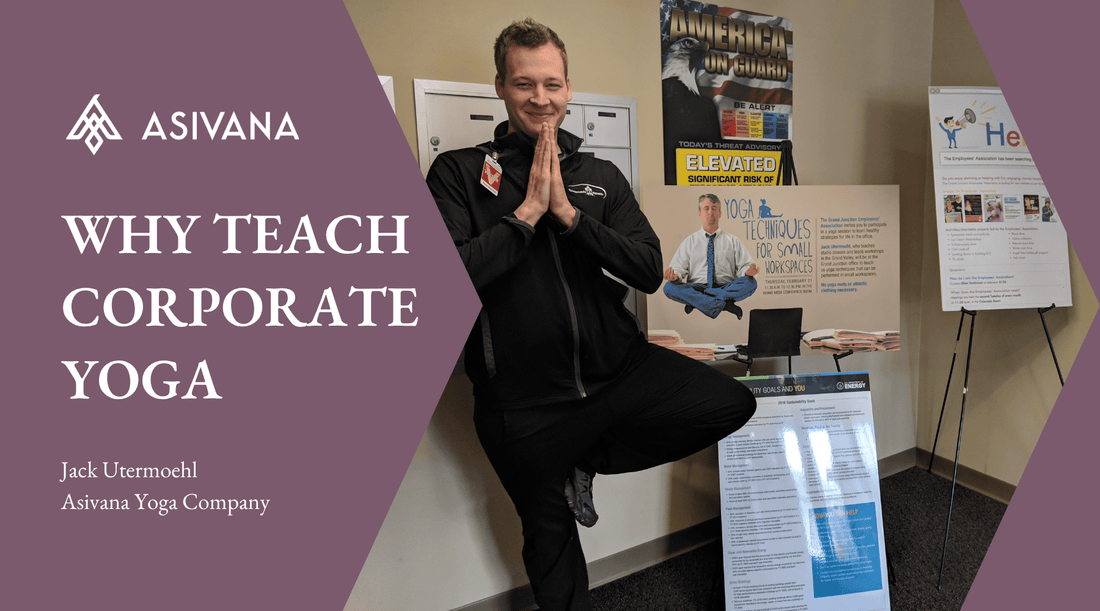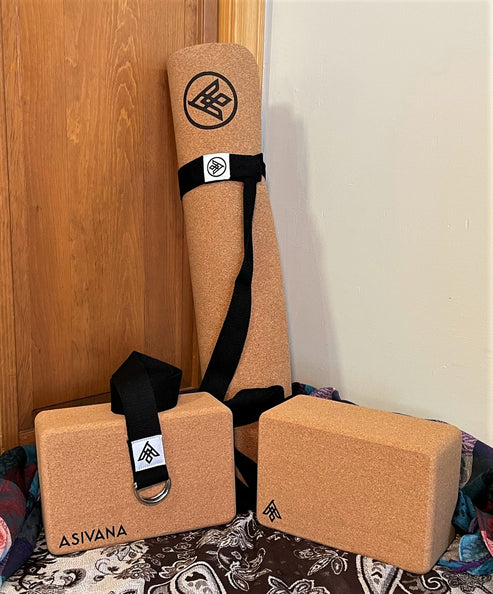Share

Why Corporate Yoga Is a Smart Move for Yoga Teachers
Jack UtermoehlShare
Corporate yoga is the practice of bringing yoga into the workplace, either in person or virtually, as part of an organization’s wellness offerings.
For yoga teachers, it’s a practical way to stabilize income, fill midweek hours, and reach students who won’t or can't come to a studio.
These classes are often well-compensated, consistent, and professionally fulfilling. You’re supporting people who need yoga most:
- Overwhelmed professionals
- Stressed leaders
- Professional teams
Teaching corporate yoga requires a shift in how we present the practice. It invites us to make yoga accessible, effective, and relevant in real time.
And for many teachers, that’s where the work starts to matter most.

Why Companies Pay for Corporate Yoga
Yoga reduces stress. That’s the entry point.
Corporate leaders aren’t investing in yoga for novelty. They’re doing it because stress is killing productivity, morale, and retention.
Employees are burned out. Absenteeism is rising. Healthcare costs are climbing. And the data is clear, companies that offer yoga and mindfulness see fewer sick days, stronger team cohesion, and better focus at work.
Corporate yoga offers a tangible return:
- Lower stress means better decisions.
- More presence means fewer mistakes.
- Movement improves posture, energy, and confidence.
- Group practice builds culture and connection.
For the company, it’s more than a perk. It’s a strategy.
And for the yoga teacher, it’s a rare intersection of purpose and sustainability. You’re offering a real world solution with short and long term value.
Yoga Essentials for Your Practice
Support your yoga journey with high-quality, sustainable props designed for comfort and stability.

Crafted from eco-friendly cork for durability and a comfortable practice.
$24
Shop Now
Includes everything you need to get started: a mat, blocks, and a yoga strap.
$120
Shop NowWhat Makes Corporate Yoga Different from Studio Classes
Corporate yoga isn’t the same as teaching at a studio. It comes with different constraints and different opportunities.
Shorter sessions. Classes often run 30 to 45 minutes, fitting into lunch breaks or transitions between meetings. You’ll need to be efficient, intentional, and clear in your sequencing.
Unconventional spaces. Boardrooms, break rooms, rooftops, or Zoom calls. Expect distractions, limited props, and tight space. Design classes that work anywhere.
Mixed-level groups. Some students are brand new. Others may have injuries or limited mobility. You’re teaching to everyone, and the priority is accessibility, not performance.
Secular language. Most companies expect a professional tone. Sanskrit, chanting, and spiritual framing should be used sparingly or even only when specifically requested. The focus is on stress relief, not spiritual depth.
Your role isn’t to replicate a studio experience. It’s to meet people where they are, at work, and give them tools they can use immediately.

How to Get Corporate Yoga Clients
Corporate clients don’t come through studio channels. You’ll need a different approach, one that blends outreach, trust, and professional presentation.
Cold pitching. Start with HR managers, wellness coordinators, or office administrators. Keep your emails short.
Focus on the benefit to their team like reduced stress, better focus, improved morale. Offer a free demo or consultation call.
Warm leads. Let your network know you’re offering corporate yoga. Past students, friends in corporate jobs, or local business contacts may open doors. Most teachers land their first clients through word of mouth.
Partnerships. Work with corporate wellness platforms, local wellness consultants, or coworking spaces that already offer programming. They handle the logistics and you show up to teach.
Demo classes. A single free class can turn into a recurring contract. Offer a short, accessible session and follow up with a simple proposal.
Your professionalism matters. Clear communication, reliable follow-through, and a polished presentation will set you apart. You’re a service provider entering (or returning) to the business world. Show up like one.
How to Structure and Price Your Corporate Yoga Offerings
Corporate clients expect clarity. Your pricing and structure should reflect that simple, professional, and easy to say yes to.
Flat rate vs per head. Most teachers charge a flat fee per class, not per student. It keeps the admin clean and reflects the value of your time and preparation. Typical flat rates range from $100–$200 per class, depending on location, experience, and format.
Packages vs single classes. Offer both, but lead with packages. A 6-week or 8-week series builds consistency and results. You might charge $150 for a single session or $800 for a 6-class series, with built-in savings for bulk commitment.
Travel and setup. If you're teaching onsite, factor in commute time, setup needs, and your own equipment (like mats, blocks, or speaker). You can include a small travel surcharge for locations beyond your standard radius.
Virtual classes. These often run slightly lower in cost ($75–$150), but are easier to scale, repeat, or record. You can offer recordings as a bonus or upsell.
Sample Pricing Example:
- 1 Onsite Class: $150
- 6-Week Series (1x/week): $800
- Virtual Class: $100
- Hybrid Package (3 virtual, 3 onsite): $725
Keep your proposals simple. Clear offerings, defined start and end dates, and professional invoices go a long way. You're solving a problem and your pricing should reflect both your impact and your time.

Explore Our Full Collection
Discover all the yoga essentials and accessories you need to enhance your practice. Shop now and elevate your yoga practice.
Shop NowTips for Teaching in Corporate Settings
Teaching in a corporate environment requires a shift in tone, presentation, and delivery. These details matter.
What to Wear
Dress in clean, neutral, professional attire. Avoid loud prints or overly spiritual symbols unless the company culture supports it. Think polished, approachable, and movement-ready. Not too tight and not too loose.
What to Bring
Keep your kit minimal: a speaker, a yoga mat, and any props that are easy to transport. For chair yoga or desk yoga, you may not need anything but your voice.
Tone and Professionalism
Speak clearly. Start and end on time. Avoid complex Sanskrit terms unless requested or used conservatively. Think workplace wellness, not studio culture. You’re there to support their workday, not interrupt it.
Adapt to the Space
If there’s no room for mats, offer chair yoga, breathwork, or short mindfulness sessions. A 30-minute stretch-and-breathe class can have lasting effects when designed well.
Encourage Consistency
Without being salesy, remind employees that regular practice brings the best results. Framing yoga as a tool for focus, energy, or peace helps them see the value and keep showing up.

Pros, Cons, and Lessons Learned from the Field
“Corporate yoga changed my teaching career. It gave me steady income and let me teach people who actually needed the practice even if they didn’t know it yet.”
- Julia, yoga teacher in Denver
Pros
- Reliable income. “I teach three classes a week at one office. It covers my rent.”
- Midday scheduling. “Corporate classes filled the gaps between my early mornings and evenings.”
- Grateful students. “They walk in stressed. They walk out human again.”
- High impact. “Sometimes a 20-minute desk stretch is more powerful than a full vinyasa class.”
Cons
- Less spiritual depth. “I missed chanting and deeper themes until I realized the breath was the teaching.”
- Logistics. “I’ve taught next to a vending machine, in heels clicking behind me. You adapt.”
- Commitment can be inconsistent. “Some staff rotate in and out. I had to reintroduce basics often.”
Lessons Learned
- Speak their language. “Stress relief” lands better than “pranayama.”
- Be flexible
- Keep your boundaries. “Start on time. End on time. Stay professional.”
- Don’t underestimate its value
Final Thoughts: Is Corporate Yoga Right for You?
Corporate yoga isn’t for everyone.
It asks you to be adaptable, professional, and clear in your purpose. You won’t always teach in serene spaces. You won’t always speak in Sanskrit. But you will meet people where they are, often at the edge of burnout, and offer something steady.
If you’re looking for weekday structure, sustainable income, and a way to bring yoga to those who might never walk into a studio, this path is worth exploring.
Ask yourself:
- Do I value accessibility over aesthetics?
- Can I communicate yoga’s benefits in plain language?
- Am I ready to show up as both a teacher and a professional?
If so, corporate yoga can be more than a side hustle. It can be service, livelihood, and impact all at once.










